
By Abhishek Hari / The Wire
New Delhi: The law of sedition was created by the British government as a tool to deal with any harsh criticism of the colonial administration and to employ it against the freedom fighters of the Indian national movement. Bal Gangadhar Tilak and M.K. Gandhi were among its most famous victims.
M.K. Gandhi referred to the law as “the prince among the political sections of the Indian Penal Code (IPC) designed to suppress the liberty of the citizens”. However, the statute was not dropped in independent India and now, after over seven decades of independence, we have witnessed a surge in the cases of sedition in recent years. So much so that the Supreme Court of India has questioned the law itself.
According to Article14, the Ministry of Home Affairs (MHA) and National Crime Records Bureau (NCRB) in 2019 and 2020, respectively, revealed a rapid increase in sedition cases since 2014.
Among the 10,938 Indians charged with sedition since 2010, 65% were booked after the Bharatiya Janata Party (BJP) government took power at the Centre in May 2014, the report said. Opposition politicians, students, journalists, authors, and academics have often been named in these cases.
In May 2021, a three-judge bench of the Supreme Court ruled in the case of Aamoda Broadcasting Company & Anr vs State of Andhra Pradesh that there is a need to define the limits of sedition under Section 124A of the IPC. The two news channels were booked with sedition for broadcasting ‘offending speeches’ made by a YSR Congress lawmaker.
The range of seditious expressions in these cases ranged from simply holding posters to social media posts to raising slogans and personal communications. For instance, in October last year, three Kashmiri students were charged with sedition in Agra for allegedly “posting celebratory messages” on social media after Pakistan’s victory over India in a T20 cricket match.
Chief Justice of India N.V. Ramana in July 2021, while hearing pleas filed by the Editors Guild of India, had criticised the law, asking: “Sedition is a colonial law. It suppresses freedoms. It was used against Mahatma Gandhi, Tilak… Is this law necessary after 75 years of Independence?”
The apex court has decided to investigate the constitutional validity of the offence of sedition in the case Kishore Chandra Wangkhemcha & Kanhaiya Lal Shukla vs. Union of India. Imphal-based journalist Wangkhem was arrested on charges of sedition for criticising Prime Minister Narendra Modi, the Rashtriya Swayamsevak Sangh (RSS) and state chief minister N. Biren Singh on social media in 2018.
What is the law of sedition?
Sedition is defined in Section 124A of the IPC as any speech or writing, or form of visible representation, which brings the government either into contempt or hatred or may excite disaffection towards the government or attempts to do so.
The punishment for sedition varies from a fine, or imprisonment up to three years to a life term, or both. It defines disaffection as “disloyalty and feelings of enmity”. However, it also states that expressing disapproval of government measures or actions or to have them changed through lawful means, without promoting hatred, disaffection, or contempt for the government, shall not fall under this section.
Colonial origin of Section 124A
The law of sedition was first introduced in clause 113 of Thomas Babington Macaulay’s Draft IPC in 1837. However, when the IPC was finally enacted after a 20-year delay in 1860, the section pertaining to sedition was mysteriously omitted, claims a study.
According to the study, the necessity of introducing the law of sedition was first recognised by the British after the revolt of 1857 in light of the increased Wahabi activities along with the incidents of mutiny against the British up until 1870. As a result, the law of sedition was incorporated under Section 124A of the IPC on November 25, 1870.
The IPC (Amendment) Act, 1898 amended Section 124A, making the effort of bringing or attempting to bring hatred or contempt (besides disaffection) towards the established government punishable. Since then, it has largely retained the same form.

Sedition lingers on in India, refusing to go away, silencing students, doctors and writers today as it did nationalist leaders a century ago. Credit: Flickr
Colonial sedition in independent India
After independence, the term “sedition” was removed from the constitution in 1948, following discussions in the constituent assembly which was adopted on November 26, 1949. Thus, Article 19(1) (a) gave absolute freedom of speech and expression. However, section 124A continued to remain in the IPC.
In 1950, two Supreme Court decisions prompted the government to enact the infamous first amendment to the constitution of India in 1951. The first case involved objectionable material in Organiser, a magazine published by the RSS, and the second was filed against a magazine called Crossroads, for opposing the government.
In both these cases, the top court ruled against the government, stating that public order is not an enumerated exception to the right to free speech. It held that freedom of speech and expression can only be curtailed if it is solely directed at undermining the state’s security. In light of these decisions, while condemning the law of sedition, Jawaharlal Nehru introduced the first amendment, empowering the state to impose “reasonable restrictions” on free speech.
However, it was only in 1973 that section 124A became a cognizable offence for the first time in Indian history by the Indira Gandhi administration under the new Code of Criminal Procedure. It authorised the police to make arrests without a warrant under Section 124A.
Why is there a surge in sedition cases after 2014?
The dominant pattern of the reports published by Article14, MHA and NCRB reveal a rapid increase in sedition cases since the BJP came into power in 2014.
These reports highlight how the BJP-ruled state governments have used sedition charges as a de-facto strategy whenever they faced public criticism or protests. During protests or events critical of the BJP government at the Centre and in the states, the database recorded an increase in sedition cases.
Steep rise under NDA
Of the nearly 11,000 people charged in 816 sedition cases since 2010, 65% were charged after the Modi government came to power in 2014.
Of the 405 Indians accused of sedition for criticising politicians and governments in the last decade, 95% were charged after 2014. Of these, 149 were accused of making “critical” or “derogatory” remarks against Modi and 144 against Uttar Pradesh chief minister Yogi Adityanath.
The data shows a 28% rise in sedition cases filed each year between 2014 and 2020, i.e. Modi’s tenure, compared to the yearly average of the second tenure of the United Progressive Alliance (UPA) administration during 2010-14.
State-wise sedition cases
The BJP was in power in four of the five states with the highest number of sedition cases during 2010-20: Bihar, UP, Karnataka, and Jharkhand. In Uttar Pradesh, 77% of the 115 cases of sedition registered since 2010 have been lodged in the last four years, after Adityanath became the chief minister.
Tamil Nadu is the only non-BJP-ruled state among the top five with 139 sedition cases since 2010. However, approximately 80% of these cases were lodged against those opposing the construction of the Kudankulam Nuclear Power Plant.
Between 2014-2019, while 326 sedition cases were filed in India, chargesheets were filed only in 141 cases and just six persons were convicted. Assam topped this list with 54 sedition cases, followed by Jharkhand (40) and Haryana (31). Bihar, Kerala and erstwhile state Jammu and Kashmir (J&K) each had 25 cases during this period while Karnataka reported 22 cases.
The nature of the cases filed in Bihar before and after the Modi government came into power in 2014 differs significantly, Article14 reported. After 2014, besides 33 Maoist cases – which increased from 16 during 2010-14 – the state also filed 20 cases against those critical of the Citizenship (Amendment) Act (CAA), celebrities and academicians who spoke out against the rising intolerance and hate crimes in the society.
The UP government similarly registered 28 and 22 sedition cases, respectively, against anti-CAA protesters and those who questioned the handling of the Hathras gang rape case. The UP government was particularly harsh on those who critiqued important BJP leaders, including Adityanath and Modi. At least 18 sedition charges have been filed against 149 such critics.
Incident-wise distribution
After Pulwama terrorist attack in 2019, 27 complaints were registered against 44 people, out of which 26 were lodged in the BJP-ruled states, for reportedly raising “pro-Pakistan” slogans and posting “anti-national” statements on social media.
During the anti-CAA protests, the authorities filed 25 sedition cases against 3,754 individuals, of which only 96 were identified and the rest were “unidentified”. Twenty-two of the 25 cases were filed in BJP-ruled states.
The Pathalgadi movement in Jharkhand, which led to hundreds of Adivasis being charged under sedition in 2018, also occurred during the BJP rule in the state.
Content-wise data
The number of sedition cases registered in 2014 were 47, 2015 (30), 2016 (35), 2017 (51), 2018 (70) and 2019 (93). The majority of those detained under sedition in 2019 were between the ages of 18 and 30; 55 individuals including a woman in this age group were arrested.
According to the NCRB report, the number of sedition cases increased by 160% between 2016 and 2019, while the rate of conviction fell to 3.3% in 2019 from 33.3% in 2016. Twenty-one cases were closed due to ‘insufficient evidence’ or ‘no clue’, two were classified as ‘false’, and six cases were determined to be civil disputes based on the final police reports.
To these first information reports (FIRs), other laws such as the Unlawful Activities Prevention Act (UAPA), Prevention of Damage to Public Property Act, Epidemic Diseases Act etc. were also added.
In 2019, 1,226 cases were registered under the UAPA – which has also been used by successive governments to quell dissent. The UAPA cases in 2019 saw a 33% rise from 2016. Nevertheless, only two convictions took place in 2018, and only one conviction was recorded in 2014, 2016, 2017 and 2019. The year 2015 saw zero convictions. As per experts, the coexistence of sedition and the UAPA controlling the same category of offences is “illogical”.
The police closed around 9% of sedition cases and 11% of UAPA cases in 2019 due to “insufficient evidence” or the accused’s untraceability, with only 17% of sedition cases and 9% of UAPA cases having chargesheets filed.
In 2019, the conviction rate for sedition cases was 3.3%, while it was 29.2% for UAPA cases in contrast to the 2019 national average conviction rate of 50.4%, which is abysmally low even by the standards of India’s low conviction rates for crimes, according to the NCRB report.
What do courts and experts have to say
The Supreme Court’s landmark decision in Kedar Nath Das v. State of Bihar (1962) established the current interpretation of the law of sedition. According to an Indian Express report, Kedar Nath Singh, a member of the Forward Communist Party in Bihar, delivered a fiery speech during a rally in 1953 leading to his conviction on sedition charges by a first-class magistrate.
He said, “Today, the dogs of CBI are loitering around Barauni… As we drove out the British, we shall drive out these Congress goondas as well…We believe in the revolution which will come, and in the flame of which, capitalists, zamindars and Congress leaders will be reduced to ashes, and on their ashes will be established a government of the poor and the downtrodden people of India.”
Singh appealed before the Supreme Court in 1962, questioning the constitutional validity of Section 124A. In a landmark verdict, a constitution bench of the top court upheld the validity of the law while acquitting Kedarnath of sedition charges.
According to the court’s interpretation, incitement to violence is a necessary component of the crime of sedition. Since then, this definition has been regarded as precedent in all matters pertaining to Section 124A.
According to the Economic and Political Weekly, Justice A.P Shah in 2017, while delivering the M.N Roy Memorial Lecture, explained the Kedar Nath judgment further: “The court upheld the constitutionality of sedition but limited its application to acts involving intention or tendency to create disorder, or disturbance of law and order, or incitement to violence. It distinguished these acts from ‘very strong speech’ or the use of ‘vigorous words’ which were strongly critical of the government.”
While referring to another landmark judgment, legal experts Moushumi Basu and Deepika Tandon wrote in EPW: “The Supreme Court in the Balwant Singh v State of Punjab (1995) case set aside the charges of sedition in relation to anti-India slogans raised in the aftermath of former Prime Minister Indira Gandhi’s assassination – Khalistan Zindabad…Raj Karega Khalsa…Hindustan Murdabad. The verdict opined that mere casual slogans having no effect on public order in terms of provocation to violence do not constitute sedition.”
What is being done about its misuse?
Human rights activists along with various civil rights organisations have demanded the repeal of Section 124A, asserting that a repressive colonial provision should have no place in any democratic country. According to them, the legislation defines sedition in a way that jeopardises citizens’ rights and liberty. It is brought into practice even when there is no danger to public order or incitement to violence.
In 2018, the Law Commission published a consultation paper requesting that the laws under Section 124A be reconsidered. It has been noted that Britain, the creator of the law of sedition along with New Zealand, Australia, Indonesia, South Korea etc. have scrapped their respective sedition laws. It has been questioned whether a law enacted by the British to repress the independence movement should still be valid in India.
Therefore, the law of sedition since its inception in 1870 has been used to silence voices of protest, dissent, or criticism of the government. Further, the Supreme Court’s Kedar Nath judgment, upholding the sedition law, was rendered at a time when doctrines such as the “chilling effect” to free speech that is causing psychological barriers through legal sanctions were unheard of.
The increasing rate of sedition cases over the last few years demonstrates that the authorities are using this exceptional law indiscriminately. The data clearly highlights that Section 124A is distinguished by its enormous misuse, subjective application, vagueness and is often used as a tool for harassment of citizens for trivial reasons.
This story first appeared on thewire.in






